Ziming Yu
Environment Reconstruction in Terahertz Monostatic Sensing: Joint Millimeter-level Geometry Mapping and Material Identification
Aug 14, 2025Abstract:Terahertz (THz) integrated sensing and communication (ISAC) offers high-speed communication alongside precise environmental sensing. This paper presents a computationally efficient framework for THz-based environment reconstruction by integrating connected component analysis (CCA)-assisted multipath component (MPC) estimation with a sliding-window refinement strategy. To start with, a monostatic sensing experiment is conducted in an indoor scenario using a vector network analyzer (VNA)-based sounder operating from 290 to 310 GHz. On one hand, as for geometry mapping, a CCA-based region search is employed to accelerate parameter extraction, significantly reducing the search space for space-alternating generalized expectation-maximization (SAGE)-based estimation and achieving an 8.4 times acceleration, while preserving resolution. Further analysis of the connected component structure enables the identification of indoor features such as flat walls and corners. A sliding-window refinement applied to the identified regions improves geometric mapping, achieving the mean distance error of 4.9 mm, which is one order of magnitude better than the literature. On the other hand, the deterministic and stochastic components of the monostatic channel are classified through reflection loss analysis. Then, material identification is performed by looking up the reflection loss in a THz time-domain spectroscopy (THz-TDS) database, which comprises over 200 materials across a 0-6 THz range. Experimental results validate millimeter-level accuracy in geometry mapping and reliable material classification, enhancing the environmental awareness capabilities of THz ISAC systems.
Centimeter-level Geometry Reconstruction and Material Identification in 300 GHz Monostatic Sensing
Oct 30, 2024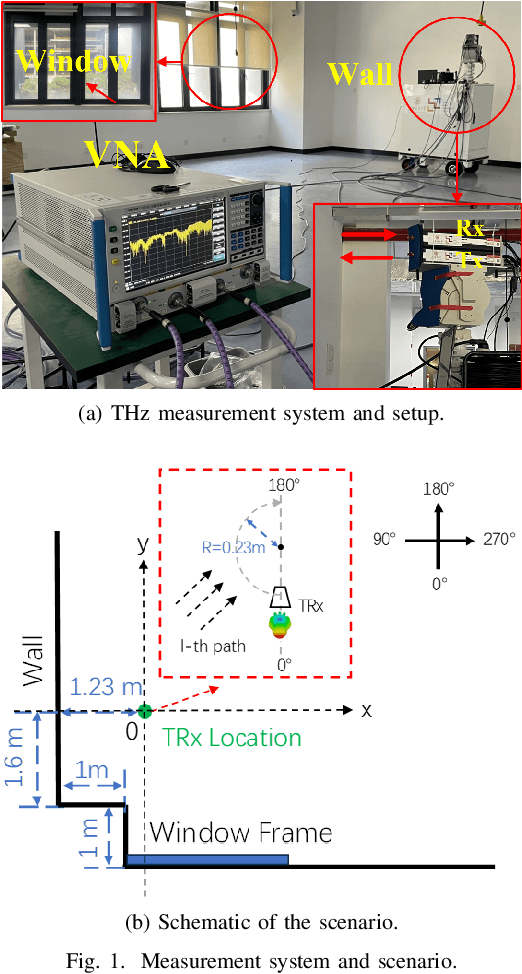
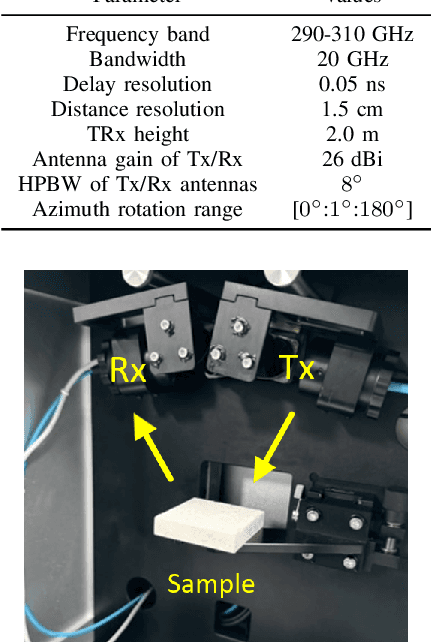
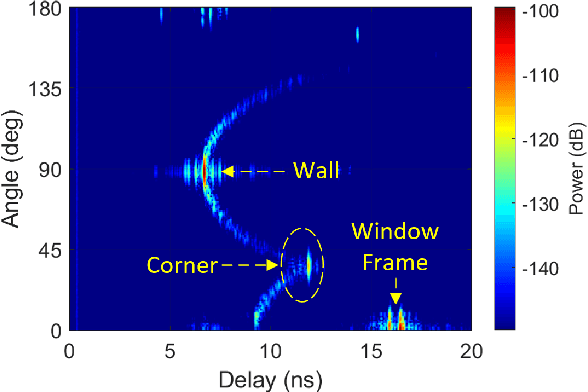
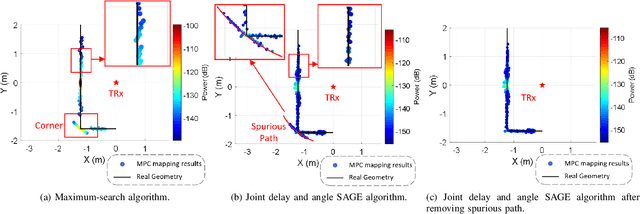
Abstract:Terahertz (THz) integrated sensing and communication (ISAC) technology is envisioned to achieve high communication performance alongside advanced sensing abilities. For various applications of ISAC, accurate environment reconstruction including geometry reconstruction and material identification is critical. This paper presents a highly precise geometry reconstruction algorithm and material identification scheme for a monostatic sensing case in a typical indoor scenario. Experiments are conducted in the frequency range from 290 GHz to 310 GHz using a vector network analyzer (VNA)-based channel sounder by co-locating the transmitter and receiver. A joint delay and angle space-alternating generalized expectation-maximization (SAGE)-based algorithm is implemented to estimate multipath component (MPC) parameters and the indoor geometry is reconstructed based on the extracted parameters. Furthermore, a geometry-based method is employed to model and remove the spurious path of the corner, reaching an accuracy of 1.75 cm. Additionally, a material database using THz time-domain spectroscopy (THz-TDS) is established, capturing reflection losses of over 200 common material samples. Applying this database to our monostatic sensing, the measured reflection losses of wall and window frame are accurately identified as cement and steel, respectively. Our results demonstrate the centimeter-level geometry reconstruction and accurate material identification for practical THz ISAC scenarios, which unleash unprecedented sensing potential compared to microwave and millimeter-wave bands.
SubZero: Random Subspace Zeroth-Order Optimization for Memory-Efficient LLM Fine-Tuning
Oct 11, 2024
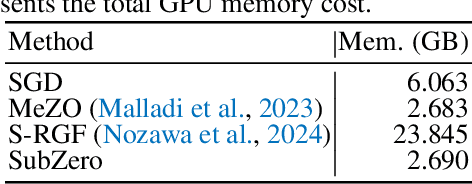
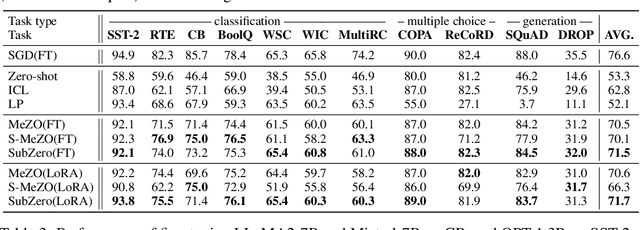

Abstract:Fine-tuning Large Language Models (LLMs) has proven effective for a variety of downstream tasks. However, as LLMs grow in size, the memory demands for backpropagation become increasingly prohibitive. Zeroth-order (ZO) optimization methods offer a memory-efficient alternative by using forward passes to estimate gradients, but the variance of gradient estimates typically scales linearly with the model's parameter dimension$\unicode{x2013}$a significant issue for LLMs. In this paper, we propose the random Subspace Zeroth-order (SubZero) optimization to address the challenges posed by LLMs' high dimensionality. We introduce a low-rank perturbation tailored for LLMs that significantly reduces memory consumption while improving training performance. Additionally, we prove that our gradient estimation closely approximates the backpropagation gradient, exhibits lower variance than traditional ZO methods, and ensures convergence when combined with SGD. Experimental results show that SubZero enhances fine-tuning performance and achieves faster convergence compared to standard ZO approaches like MeZO across various language modeling tasks.
Far- and Near-Field Channel Measurements and Characterization in the Terahertz Band Using a Virtual Antenna Array
Dec 20, 2023Abstract:Extremely large-scale antenna array (ELAA) technologies consisting of ultra-massive multiple-input-multiple-output (UM-MIMO) or reconfigurable intelligent surfaces (RISs), are emerging to meet the demand of wireless systems in sixth-generation and beyond communications for enhanced coverage and extreme data rates up to Terabits per second. For ELAA operating at Terahertz (THz) frequencies, the Rayleigh distance expands, and users are likely to be located in both far-field (FF) and near-field (NF) regions. On one hand, new features like NF propagation and spatial non-stationarity need to be characterized. On the other hand, the transition of properties near the FF and NF boundary is worth exploring. In this paper, a complete experimental analysis of far- and near-field channel characteristics using a THz virtual antenna array is provided based on measurement of the multi-input-single-output channel with the virtual uniform planar array (UPA) structure of at most 4096 elements. In particular, non-linear phase change is observed in the NF, and the Rayleigh criterion regarding the maximum phase error is verified. Then, a new cross-field path loss model is proposed, which is compatible with both FF and NF cases based on the UPA structure. Besides, multi-path fading is discovered in both NF and FF regions.
N2-SAGE: Narrow-beam Near-field SAGE Algorithm for Channel Parameter Estimation in mmWave and THz Direction-scan Measurements
Nov 28, 2022Abstract:To extract channel characteristics and conduct channel modeling in millimeter-wave (mmWave) and Terahertz (THz) bands, accurate estimations of multi-path component (MPC) parameters in measured results are fundamental. However, due to high frequency and narrow antenna beams in mmWave and THz direction-scan measurements, existing channel parameter estimation algorithms are no longer effective. In this paper, a novel narrow-beam near-field space-alternating generalized expectation-maximization (N2-SAGE) algorithm is proposed, which is derived by carefully considering the features of mmWave and THz direction-scan measurement campaigns, such as near field propagation, narrow antenna beams as well as asynchronous measurements in different scanning directions. The delays of MPCs are calculated using spherical wave front (SWF), which depends on delay and angles of MPCs, resulting in a high-dimensional estimation problem. To overcome this, a novel two-phase estimation process is proposed, including a rough estimation phase and an accurate estimation phase. Moreover, considering the narrow antenna beams used for mmWave and THz direction-scan measurements, the usage of partial information alleviates influence of background noises. Additionally, the phases of MPCs in different scanning directions are treated as random variables, which are estimated and reused during the estimation process, making the algorithm immune to possible phase errors. Furthermore, performance of the proposed N2-SAGE algorithm is validated and compared with existing channel parameter estimation algorithms, based on simulations and measured data. Results show that the proposed N2-SAGE algorithm greatly outperforms existing channel parameter estimation algorithms in terms of estimation accuracy. By using the N2-SAGE algorithm, the channel is characterized more correctly and reasonably.
Terahertz Channel Measurement and Analysis on a University Campus Street
Nov 21, 2022



Abstract:Owning abundant bandwidth resource, the Terahertz (0.1-10 THz) band is a promising spectrum to support sixth-generation (6G) and beyond communications. As the foundation of channel study in the spectrum, channel measurement is ongoing in covering representative 6G communication scenarios and promising THz frequency bands. In this paper, a wideband channel measurement in an L-shaped university campus street is conducted at 306-321 GHz and 356-371 GHz. In particular, ten line-of-sight (LoS) and eight non-line-of-sight (NLoS) points are measured at the two frequency bands, respectively. In total, 6480 channel impulse responses (CIRs) are obtained from the measurement, based on which multi-path propagation in the L-shaped roadway in the THz band is elaborated to identify major scatterers of walls, vehicles, etc. in the environment and their impact on multi-path components (MPCs). Furthermore, outdoor THz channel characteristics in the two frequency bands are analyzed, including path losses, shadow fading, cluster parameters, delay spread and angular spread. In contrast with the counterparts in the similar outdoor scenario at lower frequencies, the results verify the sparsity of MPCs at THz frequencies and indicate smaller power spreads in both temporal and spatial domains in the THz band.
306-321 GHz Wideband Channel Measurement and Analysis in an Indoor Lobby
Nov 21, 2022Abstract:The Terahertz (0.1-10 THz) band has been envisioned as one of the promising spectrum bands to support ultra-broadband sixth-generation (6G) and beyond communications. In this paper, a wideband channel measurement campaign in an indoor lobby at 306-321 GHz is presented. The measurement system consists of a vector network analyzer (VNA)-based channel sounder, and a directional antenna equipped at the receiver to resolve multi-path components (MPCs) in the angular domain. In particular, 21 positions and 3780 channel impulse responses (CIRs) are measured in the lobby, including the line-of-sight (LoS), non-line-of-sight (NLoS) and obstructed-line-of-sight (OLoS) cases. Multi-path propagation is elaborated in terms of clustering results, and the effect of typical scatterers in the indoor lobby scenario in the THz band is explored. Moreover, indoor THz channel characteristics are analyzed in depth. Specifically, best direction and omni-directional path losses are analyzed by invoking close-in and alpha-beta path loss models. The most clusters are observed in the OLoS case, followed by NLoS and then LoS cases. On average, the power dispersion of MPCs is smaller in the LoS case in both temporal and angular domains, compared with the NLoS and OLoS counterparts.
Joint Channel Measurement and Simulation Analysis in an L-shaped Indoor Hallway in the Terahertz Band
Aug 08, 2022Abstract:The Terahertz (THz) band (0.1-10~THz), which supports Terabit-per-second (Tbps) data rates, has been envisioned as one of the promising spectrum bands for sixth-generation (6G) and beyond communications. In this paper, an angular-resolvable wideband channel measurement campaign in an indoor L-shaped hallway at 306-321~GHz is presented, by using a frequency-domain vector network analyzer (VNA)-based channel sounder. Four line-of-sight (LoS), six quasi-line-of-sight (QLoS) and eight non-line-of-sight (NLoS) receiver points are measured. However, measured data spreads due to the rich scattering environment and the antenna pattern, which puzzles traditional clustering algorithms. To solve this problem, a simulation-assisted Density-Based Spatial Clustering of Applications with Noise (DBSCAN) clustering algorithm is proposed, where the deterministic simulation result is extracted to adapt the conventional DBSCAN algorithm. The proposed algorithm outperforms conventional clustering algorithms like DBSCAN, K-means, and K-power-means in terms of Silhouette, Calinski-Harabasz and Davies-Bouldin indices. Furthermore, the THz multi-path propagation in the L-shaped hallway is elaborated, and channel characteristics of multipath and clusters are analyzed in depth.
 Add to Chrome
Add to Chrome Add to Firefox
Add to Firefox Add to Edge
Add to Edge